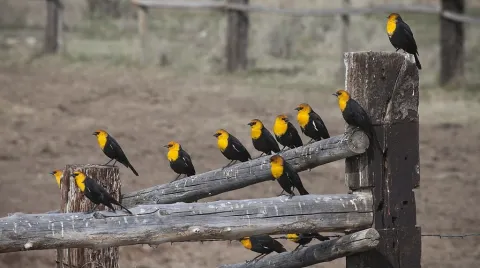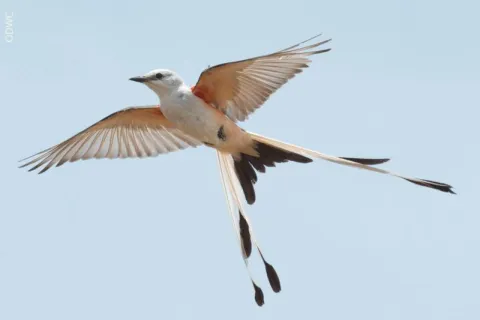Intriguing Birds

Photo by USFWS. Yellow-headed blackbirds at Cokeville Meadows, Wyoming
I recently read a report that said in the past five decades, North America’s bird population has decreased by over 3 billion individuals. That’s Billion with a capital “B.” And that is only in North America. The reports are similar in Europe, South America and other parts of the world. So what happens when we no longer have chance encounters seeing unique and intriguing birds? The norm will be that the next generation won’t miss them because they weren’t ever aware of their existence. Clear as mud? Well, say a hundred years ago, Grandpa Smith remembered passenger pigeons flying overhead in huge flocks, but they had disappeared by the time he was an adult. His grandson had never seen any, so ‘out of sight, out of mind.’ What he sees in the sky is a norm without the extinct bird.
I have seen some unique birds in my lifetime, but those encounters are getting fewer and further between. When I was a tween, my grandfather, whom I called Daddy Pat, would take me to places like Lake Overholser (Oklahoma) when we went out to visit. He wanted me to see the painted and indigo buntings. They were hard to find then, but he would patiently tell me to listen and I would hear their songs. I caught a glimpse of an indigo and was entranced. I have not seen any since.
We reciprocated when Dad retired and moved to Paradise, Utah. Mother and Daddy Pat came out to visit when the blackbirds were nesting in nearby Sardine Pass. The birds he most wanted to see were the yellow-headed blackbirds. They nested among the cattails along the two-lane Highway 89. He was ecstatic and it was a real trick pulling off the road enough for him to observe the noisy birds. Recent visits to northern Utah have shown no more yellow-headed blackbirds in the pass, or even cattails, which disappeared when the highway was made a four-lane road.
More recently, I was picking raspberries at a winery near Cleveland, Tennessee. I love the taste of fresh raspberry jelly. I managed to get up there shortly after dawn, was busily picking my bucket of berries when I heard a bird song I hadn’t heard before. I looked up and saw a brilliantly red bird. It wasn’t a cardinal. Different body shape and no crest. I had seen scarlet tanagers, but never one completely red. I looked it up when I got home and found out it was a summer tanager. Check out the video: https://www.youtube.com/watch?v=EI3pZ3t2i4E
Oklahoma’s state bird is the scissortail flycatcher, a unique little bird with a very big tail and a bigger appetite for bugs. In the sixties I saw them in the neighborhood where I lived. Recent sojourns revealed nary a one. Then I drove outside Oklahoma County (the same thing as saying Oklahoma City) and saw something I hadn’t even seen in the ‘old days.’ Between a small field and a neighborhood in Canadian County was a row of power lines. Every evening just before dark, the flycatchers had a convention. Dozens, hundreds of them! I stopped and listened one night and enjoyed the twittering, fluttering, and swooping scissortails. They are delightful birds. It would be sad to see them disappear.
The Washington Post article said the study didn’t indicate any particular birds nearing extinction, only a general condition and a warning. “Birds, because they are so well-monitored, should be viewed as canaries in coal mines, the authors argue — harbingers of a wider environmental malaise at a time when other creatures, including insects, are also thought to be fading but are more challenging to count.” The article also didn’t indicate what an individual could do to help the situation, just generalities about why this situation is happening. I don’t have to list those here; I think we know them. I don’t have any solutions, but perhaps we need to pay closer attention to the world around us. Maybe there are small things we can do to help reverse this trend. It would be sad to lose the song of a bird, or the glorious sight of monarchs migrating each year.
Susan Kite is a member of Author’s Guild of Tennessee. She has five published books, and several stories in anthologies. Check them out at: https://www.amazon.com/default/e/B00J91G0ZU/
- Log in to post comments

Nice article
One of the biggest things I miss about living in Florida is the wide variety of birds. Living in Clearwater, I would routinely see cranes, storks, red-shouldered hawks, ospreys, wild canaries, and even bald eagles. My favorite was the Lesser Blue Heron. I think that's the most beautiful bird there is. It's not all that showy, but it's elegant and has such deep blue plumage. That video you linked to was pretty special. That's one stunning bird!
birds
Seeing a summer tanager was pretty cool, too. There are some really great birds in Tennessee. I will have to do something about the Crane festival. Saw a whooping crane there as well as the sandhill cranes and other birds. We used to have hummers and finches in a few places we lived in, too.